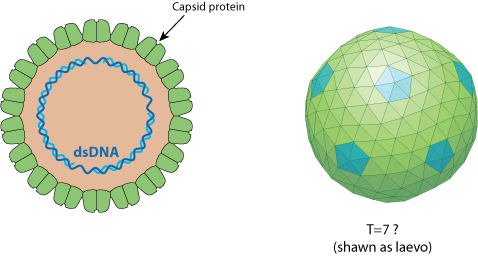Solendovirus (taxid:1232640)
VIRION

Non enveloped, large (50 nm diameter) icosahedral particles with a T=7 symmetry composed of 420 subunits. It has not been described whether handedness of capsid is laevo or dextro, here the pictures dsplays a laevo form.
GENOME
Monopartite, open circular, double stranded DNA of 7.7 kb. with each strand of viral DNA being interrupted by a site-specific discontinuity. ORF1 codes for the capsid protein, ORF2 for a movement protein, ORF3 for a replicase polyprotein and ORF4 product is a transactivator.
GENE EXPRESSION
ENZYMES
- Reverse transcriptase
- RNAse H [RT]
- Polyprotein protease (Peptidase A3) [PRO]
REPLICATION
CYTOPLASMIC / NUCLEAR
- Attachment of viral proteins to host receptors mediates entry into the host cell.
- The viral dsDNA is released into the nucleus.
- Transcribed by host RNA polymerase II.
- mRNA translation produces viral proteins.
- Genomic RNA is retrotranscribed into new dsDNA genomes in the cytoplasm.
- Genomes are encapsidated by the capsid protein and form new virions.
- The virion infects either a new cell by plasmodesmata movement, or by insect vector uptake.
